If you are looking for a quickly maturing goose breed to add to your flock, look no further than the Emden goose. Backyard enthusiasts will love its peaceful and friendly nature.
This breed’s remarkable egg-laying abilities and high meat quality make it ideal for rearing. The Emden goose is a sturdy and obedient bird that thrives both outdoors and indoors.
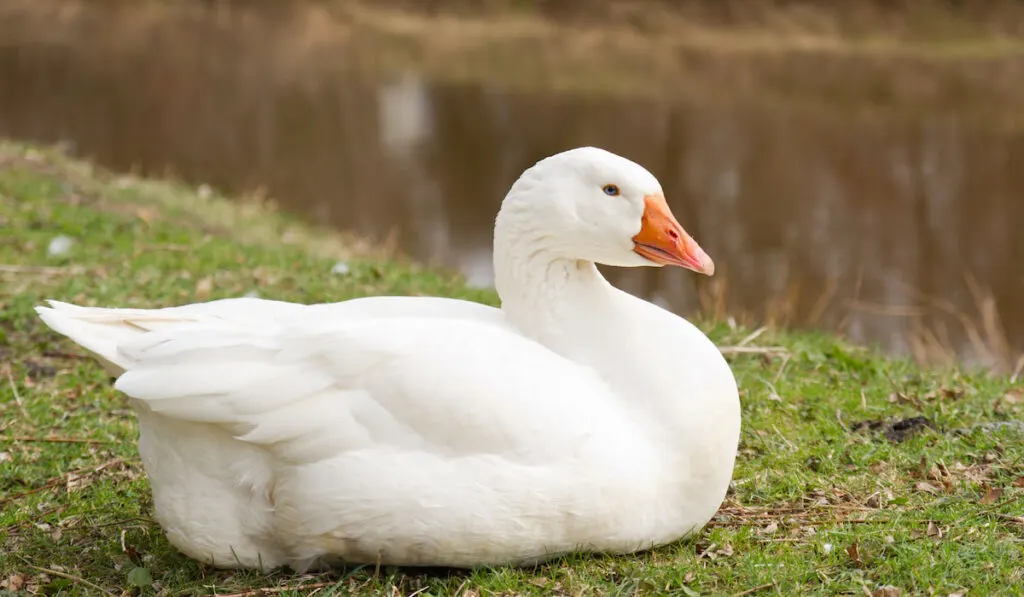
Table of Contents
History and Origin
The Emden is a domestic goose breed that originated in the town of Emden, located in northwest Germany.
This breed is one of the earliest domesticated goose breeds. According to early documentation, the Emden goose came from breeding local German geese with foreign species.
The breed rose to prominence in Germany in the late 19th and early 20th centuries. The bird then spread to other European nations and North America.
The first Emden geese came to Boston in 1821, where they were known as “Bremens.”
The breed gained popularity throughout the 20th century for its superior egg-laying ability, meat quality, and hardiness. The Emden goose is still highly valued today.
Is the Emden Goose Recognized by the APA?
Yes, the Emden goose is recognized by the APA. The breed first received recognition as a standard breed in 1874.

Breed Standards
Here are the Emden goose breed characteristics as set by the APA standards:
Appearance
The Emden goose is a big, fat bird with a short neck and a broad head.
Feathers
The bird’s feathers are thick with a soft, downy feel. Geese preen their feathers to keep them healthy and protect their general well-being.
The oil gland at the base of the bird’s tail is well-developed.
Colors
Pure white is the breed’s most popular color. However, you can also find a few in other hues.
The rare-colored variants, such as blue or gray, are more expensive.
Beak
Emden geese have medium-length yellow beaks with a slightly rounded white tip. The birds use their bills for self-defense, grooming, and foraging.
Temperament
Emden geese are docile, friendly, and easy to handle.
They don’t exhibit any signs of hostility or shyness.
However, ensure you begin socializing them at a young age.
Standard Measurements
The Emden goose is one of the tallest and heaviest goose breeds. Adult Emden geese stand up to 3.3 feet (100 cm) tall.
Females can weigh up to 28 pounds (12.7 kg), while ganders weigh between 28 and 34 pounds (12.7-15.4 kg).
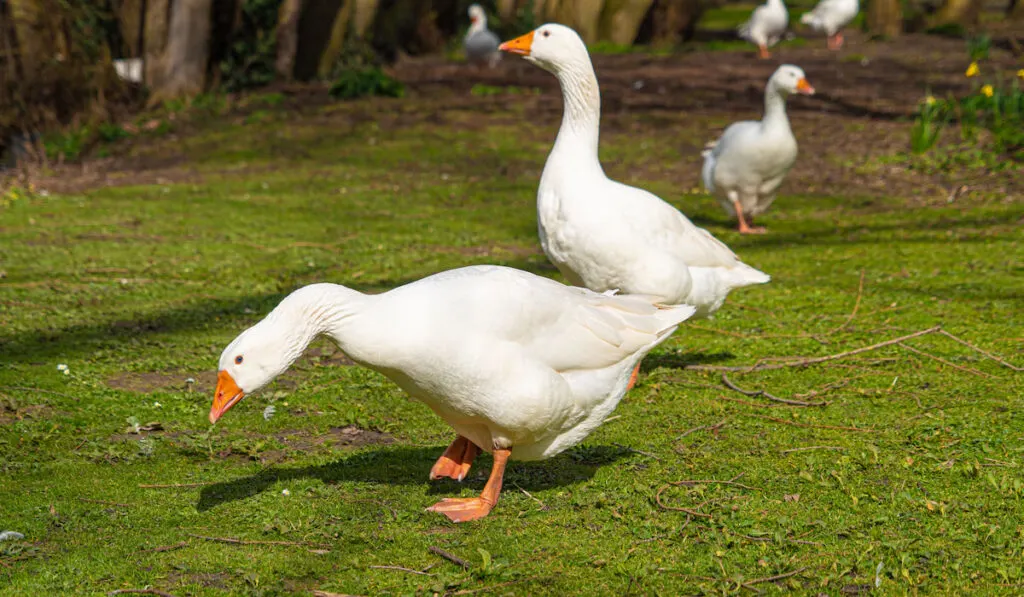
Breed Purposes
Most people raise the Emden geese for their meat. However, you can keep them for their eggs, down, and as pets or ornamental birds.
Meat Production
Emden geese are excellent meat producers. Their size and high-quality flesh make them suitable for commercial meat production.
The geese reach a slaughter weight of 33 pounds (15 kg) for males and 20 pounds (9 kg) for females within 8 to 12 weeks. However, this depends on their nutrition and growth rate.
Ensure you feed them a well-balanced diet with high-quality feed. Include lots of green forage for the best results.
Egg-Laying
Emden geese produce about 40 eggs a year, each one weighing around 6 ounces (170 g) on average.
However, these geese can lay more eggs if well-fed. Make sure to keep their environment warm and dry.
Other Uses
In addition to meat and egg production, you can raise Emden geese for the following purposes:
- Pets: Emden geese are peaceful and beautiful birds and make excellent pets.
- Ornamental birds: You can keep these geese as ornamental birds for their attractive looks.
- Down and feathers: You can use their down feathers for clothes, bedding, and pillows.
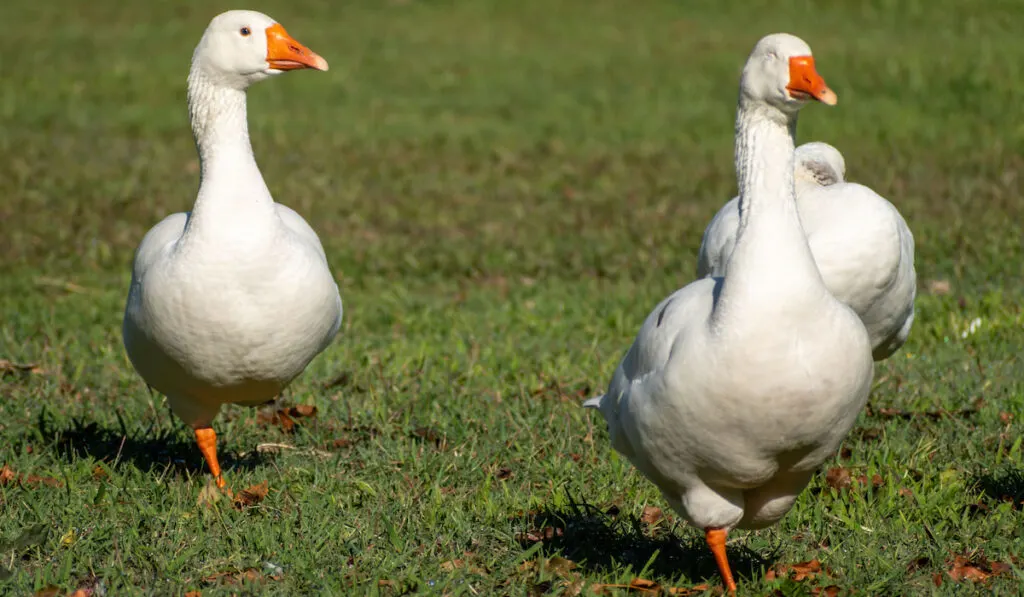
Sexing (How to Distinguish Male and Female)
There are several ways to distinguish male and female Emden geese.
Size
Males are heavier, with more sizeable frames and more developed chests than females. They also have long, graceful necks and more prominent feathers on their collars.
Vocalization
Male and female Emden geese make different vocalizations.
Female birds often have a higher-pitched, more nasal cry. In contrast, males have a deeper, more resonant honk.
Behavior
Female Emden geese are more submissive and caring. In contrast, male birds tend to be more assertive and protective of their mates.
Ganders also exhibit wooing behaviors during the breeding season, such as honking and flapping their feathers.
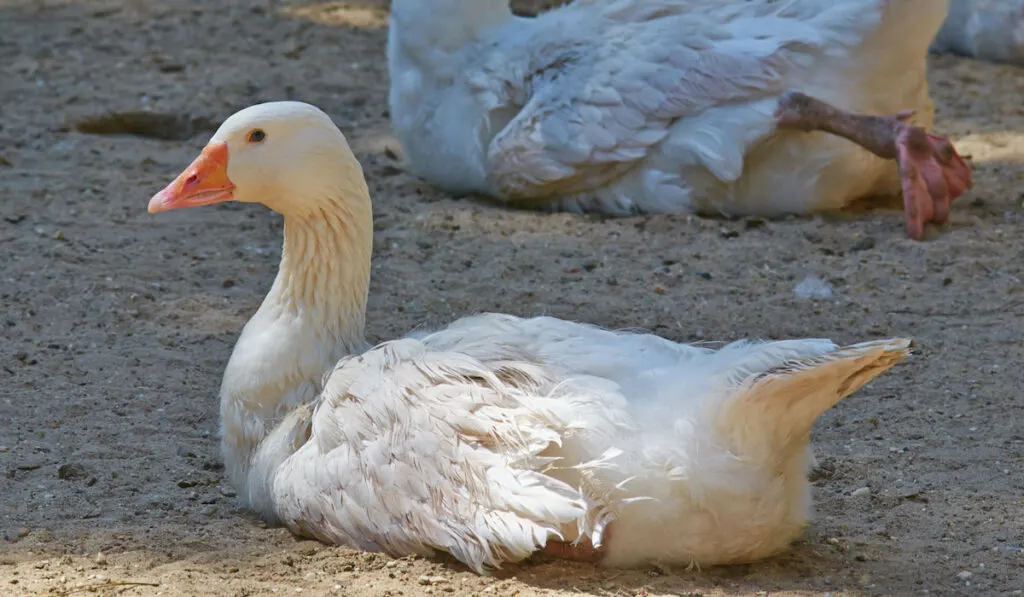
Hatching/Raising
Incubation
The incubation period lasts 28 to 30 days for Emden geese. You can let the female geese hatch the eggs or use an incubator.
If using an incubator, you should rotate the eggs several times a day and ensure you maintain a temperature between 99.5°F and 100°F and a relative humidity of 60%.
However, most of the time, the goslings can hatch independently without help.
Brooding
Keep the goslings warm and shield them from any cold air as they hatch.
When brooding, remember to use heat lamps, a brooder box, or a warm spot in your house. Emden goslings need a temperature between 95°F and 100°F (35°C-38°C).
Feeding
Newly hatched goslings require food, water, and a warm and safe shelter.
To help them grow well, give them high-quality starter feed with grass and other greens. As they mature, you can start giving them grower feeds.
Gradually transition them to a maintenance diet of grains, vegetables, and pasture.
Housing
Provide plenty of space for the geese to roam and exercise as they grow.
They are friendly birds that thrive well in small groups. Consider keeping multiple Emden geese so they can socialize with each other.
Health
Keep your birds healthy with routine veterinary checkups. Also, practice proper hygiene habits and provide them with a balanced diet.
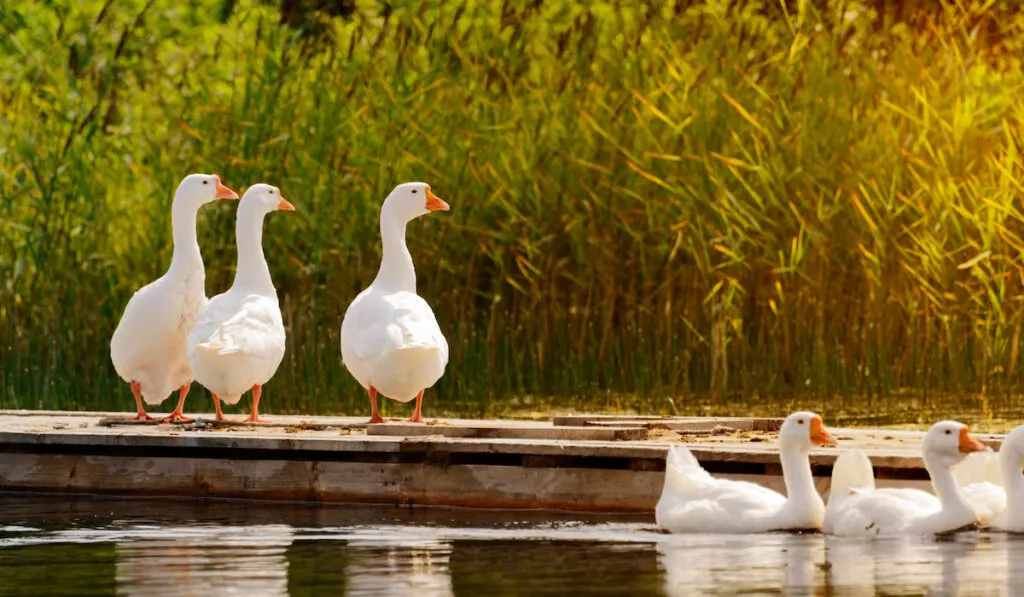
Noise Level
Like most domestic geese, Emden geese are noisy animals. They can honk, hiss, and bray.
These birds are boisterous when they feel threatened or defend their young.
If you confine the Emden goose in small spaces, they will make a lot of noise.
They tend to make more noise when they are in noisier areas. For instance, they will honk even louder if they hear another goose honking nearby.
Cold and Heat Tolerance
Emden geese are resilient and adaptable to varying weather conditions.
Cold Tolerance
These birds are cold-hardy; they can withstand severe winter weather. Their dense, downy feathers insulate them from the cold.
Heat Tolerance
While the Emden goose can endure cold weather, it struggles in hot weather.
You can help keep them cool and prevent heat stress by providing adequate shade and plenty of cool water. Also, ensure their living space is well-ventilated.
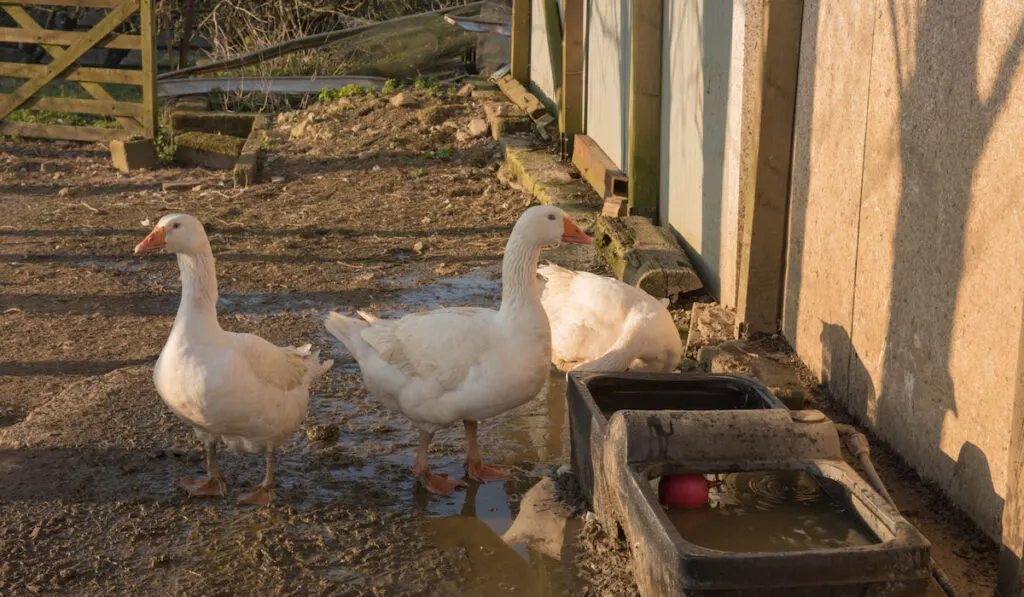
Common Health Issues
Like other domestic birds, Emden geese are prone to various contagious and non-contagious illnesses.
The following are some of the most common health issues affecting Emden geese.
Parasites
Lice, mites, and worms can affect your birds and compromise their health. These parasites can lead to itching, skin irritation, and poor feather quality.
Respiratory Problems
Emden geese are also prone to various respiratory issues, including pneumonia, bronchitis, and avian influenza.
These illnesses may result in coughing, sneezing, and breathing difficulties.
Egg-Laying Problems
Female Emden geese can encounter problems related to egg production.
For example, they could start laying smaller eggs or eggs with poor-quality shells. In addition, they can also suffer from egg binding.
Factors like bad diet, stress, or illness contribute to these issues.
Foot and Leg Problems
Emden geese can encounter some foot and leg issues:
- Bumblefoot
- Joint problems
- Leg swelling
- Lameness
Factors contributing to foot and leg problems include inadequate dietary intake, unclean living conditions, injuries, and excessive weight.
Obesity
The Emden goose gains weight fast and is prone to obesity. Obesity causes heart disease, liver issues, and decreased mobility.
Obesity can be a result of overfeeding or lack of exercise. This is why it is crucial for them to have a large area to roam.
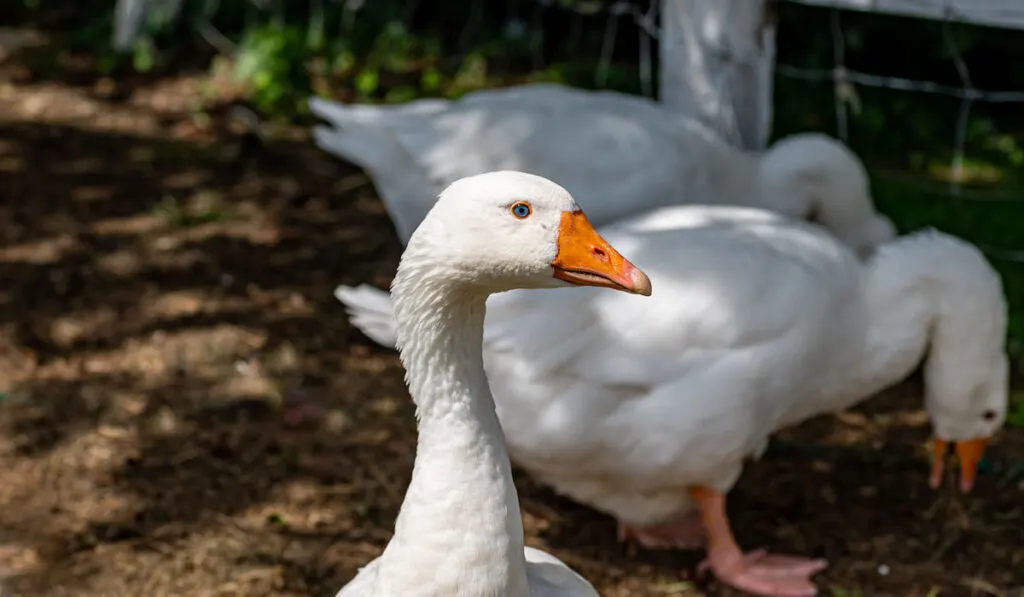
Pros and Cons
Like any other animal, raising Emden geese has advantages and disadvantages.
Advantages
Meat Production
The Emden geese are enormous birds that produce quality meat. Their meat is ideal for roasting and grilling, thanks to its rich taste.
Egg Production
These birds are good layers. They lay sizeable, nutritious, and tasty white eggs.
Hardiness
The Emden geese are a resilient breed. They can thrive in various settings, even in cold climates.
Additionally, they are easy to maintain.
Friendly Disposition
These geese have gentle and pleasant dispositions. They are a good choice for those new to the world of geese rearing.
Disadvantages
Space Requirements
Emden geese are active birds that need a lot of space to roam. You will need to build a large coop or pen if you live in an urban setting or have a small yard.
Feed Costs
Since they eat voraciously, Emden geese need high-quality feed to be healthy and productive. Thus, they are somewhat expensive to maintain.
Noise
These birds sometimes make loud, aggressive vocalizations. The noise could annoy your neighbors.
Moreover, they can draw unwanted attention from predators, like foxes, raccoons, and coyotes.
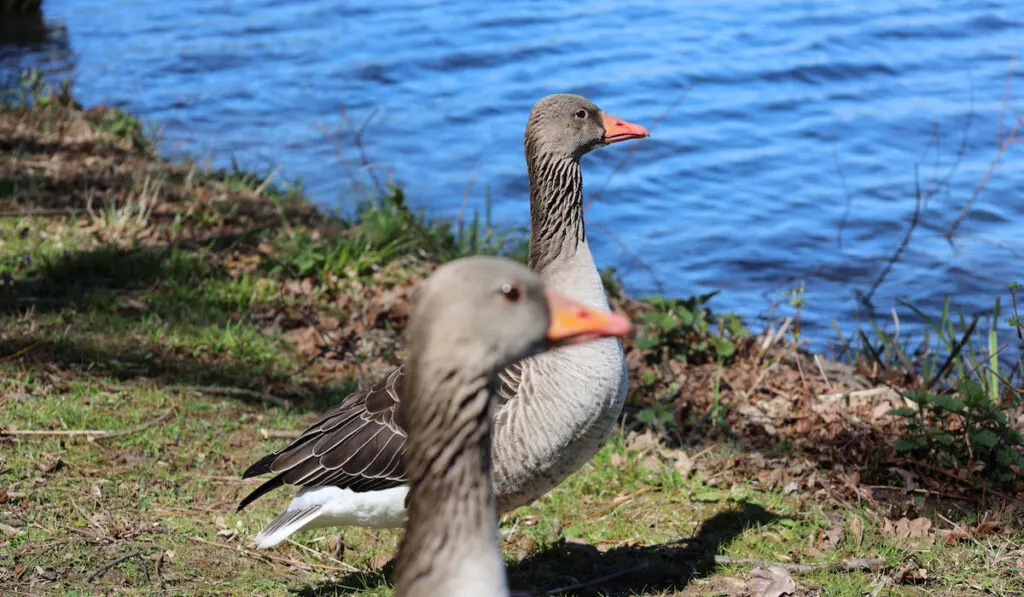
Similar Breeds
These are several breeds that are similar to the Emden in size and look.
Toulouse Goose
This breed is similar to the Emden in size and body structure. Toulouse geese are famous for their meat’s deep, rich flavor. Also, they are docile and friendly.
However, you can distinguish the two breeds by their plumage. The Toulouse goose has grey plumage, while the Embden is pure white.
American Buff Goose
The American Buff goose is about the same size as the Emden goose. This breed is a good meat and egg producer and is peaceful and kind.
However, the American Buff has an apricot fawn plumage, while the Emden’s feathers are white.
Roman Goose
The Roman Goose is comparable in size and build to the Emden goose. It is also excellent for egg and meat production.
These two closely resemble each other. However, the Emden goose has an orange bill, whereas the Roman goose has a pinkish bill.
Pomeranian Goose
The Pomeranian goose is a medium-sized goose breed with a similar disposition to the Emden goose. This breed is ideal for meat and egg production.
The Pomeranian goose’s gray or buff saddleback and head distinguish it from the Emden, which is pure white.
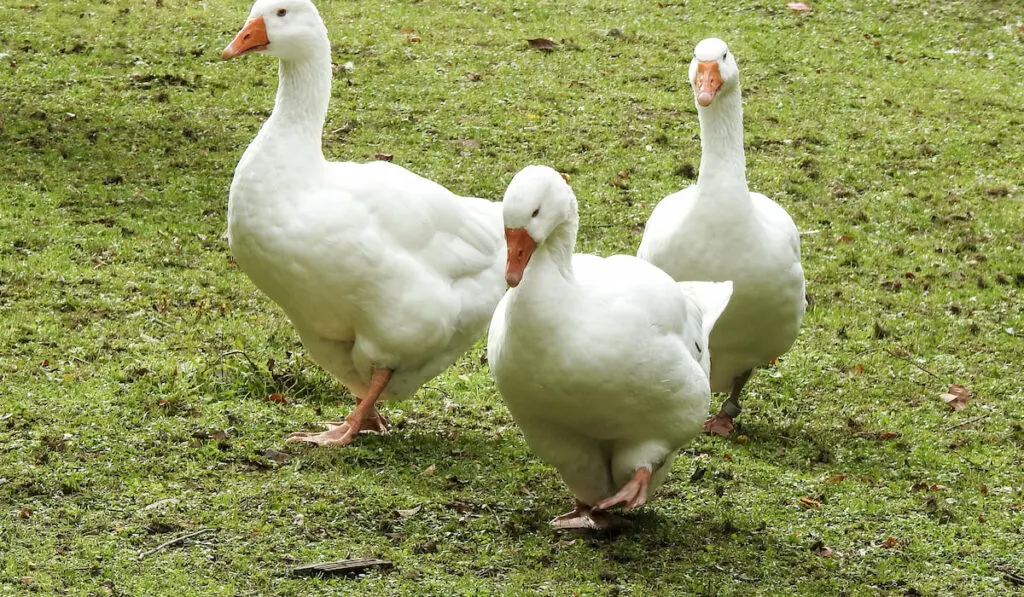
Frequently Asked Questions (FAQs)
The Emden goose originated in the northwestern German town of Emden.
Emden geese have friendly, calm, and submissive personalities.
Male Emden geese weigh 28–34 pounds (12.7-15.4 kg), while females weigh about 28 pounds (12.7 kg).
Yes, Emden geese are excellent layers; they produce 30–40 eggs annually.
Emden geese live for 10 and 15 years.
Yes, Emden geese are superb foragers.
Yes, you can raise Emden geese alongside other birds, such as chickens, ducks, and turkeys.

Final Thoughts
The Emden goose is a hardy, docile, and highly productive breed. You can raise it for meat and egg production.
Moreover, they can also be good pets or ornamental birds for exhibitions. There are many reasons to consider the Emden goose for your backyard!
Resources
I wrote this article from my experience raising geese and the following sources:
- https://opensanctuary.org/common-goose-health-issues/
- https://www.chickens.allotment-garden.org/keeping-geese/geese-diseases-parasites-worms-lice-mites/
- https://extension.psu.edu/infectious-bronchitis-in-chickens
- https://www.sciencedirect.com/topics/immunology-and-microbiology/anser-anser
- https://www.poultryhub.org/all-about-poultry/species/fancy-goose-breeds
- https://www.ncbi.nlm.nih.gov/pmc/articles/PMC4019135/
- https://zoologyfoundation.org/duck-duck-goose/
- https://breeds.okstate.edu/poultry/geese/embden-geese.html
- https://web.extension.illinois.edu/eggs/res21-poorhatches.html
- https://www.waterfowl.org.uk/domestic-waterfowl/heavy-geese/embden/
